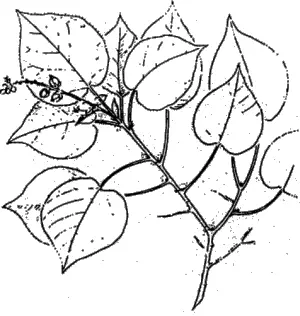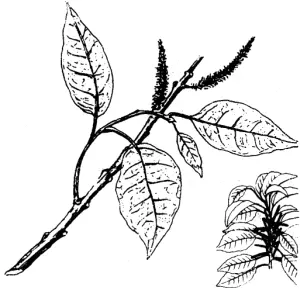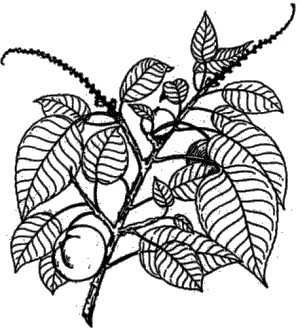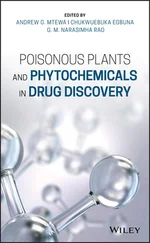Occurrence:Approximately 200 species are native in tropical and subtropical America, also introduced to other continents. Frequently found in dry places. Also popular as a house plant.
Description:Cactuses in the form of shrubs or small trees with oval, flat segments and wide funnel-shaped yellow or red blossoms. Petals small, cylindrical, drop a short time after they appear. Opuntia can be an important survival plant in the desert: The egg-shaped fruits are edible uncooked when peeled. Clear potable water can be squeezed out of the segments. Peeled young segments are edible after cooking.
Effects:Mechanical, partly chemical. Most cactuses are armed with thorns, but Opuntia is among the most unpleasant ones because its fine thorns break off after the lightest touch and penetrate the skin easily. If dirt covers the plant, it can enter the skin with the thorns. Contact with the plant can result in papules and pigment changes which disappear after several months. The symptom is named Sabra Dermatitis and resembles scabies.
Measures:As far as possible, remove the thorns carefully from the skin with adhesive tape or a pair of tweezers. Tetanus prophylaxis.
Reference:Behl; Benezra
Similar plants:Other Cactus species.

Antiaris toxicaria Lesch
Moraceae family (Mulberry family)

Synonyms: Antiaris, Ipoh
Other scientific names: Upas antiar Lesch.
Occurrence:Tropical Asia, east to Timor. Notably Java, Sulawesi and the islands nearby. Tonga. Tropical Africa south to Angola and Zambia.
Description:Large evergreen tree up to 75 m tall, often with buttresses at the base of the trunk. Fruits reddish, fleshy, velvety, 20 x 13 mm, on a 10 mm long stalk, containing 1 seed each. Highly poisonous, milk-white or yellowish latex in leaves and bark. It turns brownish and waxy when exposed to air.
Effects:The latex is highly poisonous. It partially dissolves in alcohol. On some individuals it causes swellings and eruptions on the skin. Small doses in the bloodstream act upon the vasomotor centers, producing increased arterial tension. Larger doses can paralyze the heart muscle and result in death. A skin abrasion caused by a broken branch can already kill a person, and the wood of this tree is definitely unsuitable as building material. The latex (also called Ipoh in Malay) was traditionally used by hunters to prepare poisoned arrows.
Measures:[Not described in literature.] Immediate washing of the skin with water and soap should help removing the latex.
Reference:Merrill(2); Felter; Flora of Ethiopia
Similar plants:Other subspecies of Antiaris occurring in Australia and Madagascar. There are other types of several botanic families which contain highly poisonous sap in certain parts, which should under no circumstances get into the bloodstream, like the seeds of Abrus precatorius and Strychnos nux-vomica.

Cnidoscolus stimulosus
Euphorbiaceae family (Rubber family))

Synonyms: Spurge Nettle (en), Tread-Softly (en
Occurrence:South-eastern USA from Virginia south to Florida and Texas. On waysides, fields, and sandy grounds.
Description:Height up to 60 cm. The white blossoms appear from the end of March to September. All parts above the ground are covered with stinging hairs.
Effects:Mechanical-chemical by stinging hairs. After touching severe burning and itching occurs immediately. Reddening of the skin and perhaps blistering.
Measures:Corticosteroid ointment, medical attention, Tetanus prophylaxis.
Reference:Peterson

Croton ciliato-glandulosus
Euphorbiaceae family (Rubber family)

Occurrence: Central America and Mexico. Frequently in the underwood in dry locations.
Description:Up to 1 m tall shrub with small light green blossoms. leaves and stalks are covered with whitish hairs.
Effects:The hairs of the plant cling to the hands when touched. If these come then in contact with the eyes, serious eye inflammations can result. Cattle grazing between these shrubs have been reported to have gone blind.
Measures:Washing hands after touching the plant. If hairs got into the eyes, rinse eyes with water and search medical attention immediately.
Reference:Dahlgren

Excoecaria agallocha L.
Euphorbiaceae family (Rubber family))

Synonyms: Blind-Your-Eye (en), Buta-Buta (id
Occurrence:In many parts of the tropical world in mangrove forests and brackish swamps.
Description:Small tree up to 14 m tall, resembling the Mangrove, with leaves 6 to 10 cm long, alternate and evergreen. The tiny, fragrant blossoms are yellowish-green, the fruits resemble peas. The plant contains a milky sap.
Effects:Chemical. When the latex gets into the eye, this can result in blindness. When it gets on the skin, severe burning, inflammation, blistering and permanent damage are to be expected. All parts of the plant are also poisonous when ingested. The plant is known to be a fish poison.
Measures:Washing of the skin, application of corticosteroid ointment. Immediate washing of the eyes with water, professional medical treatment.
Reference:Behl
Similar plants:Most members of the Rubber Family (Euphorbiaceae) contain a milky sap which is skin-irritating and very poisonous, sometimes also carcinogenic.

Hippomane mancinella L.
Euphorbiaceae family (Rubber family)

Synonyms: Manchioneal (en), Manzanillo-Baum (de)
Occurrence:Native in tropical America, growing in dense groups along ocean beaches. Occasionally cultivated in India and other tropical countries.
Читать дальше



















